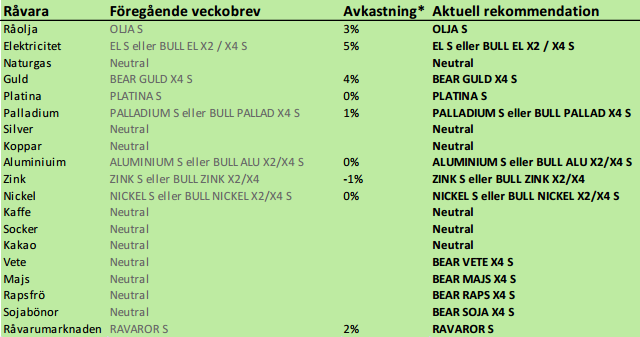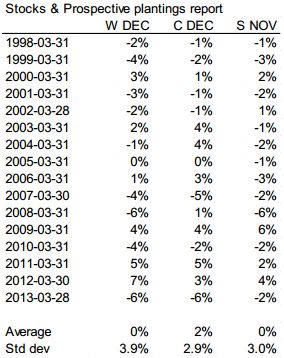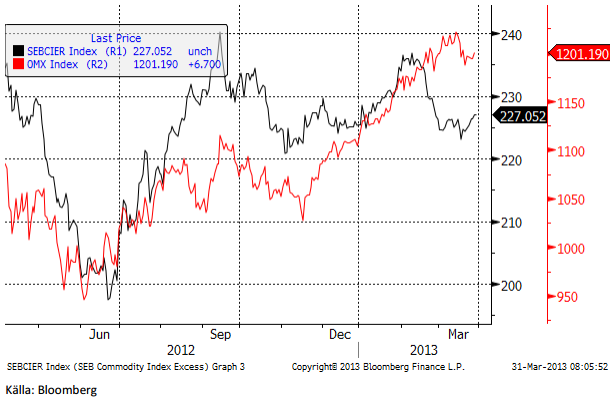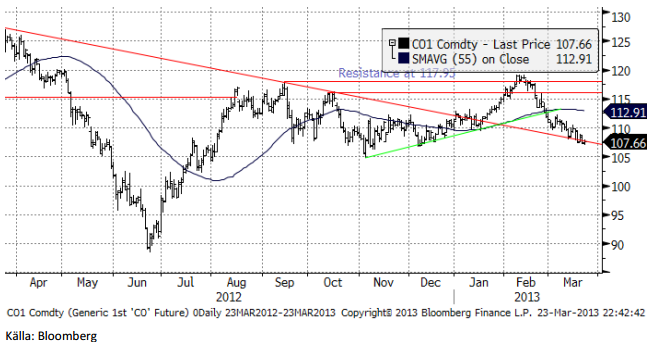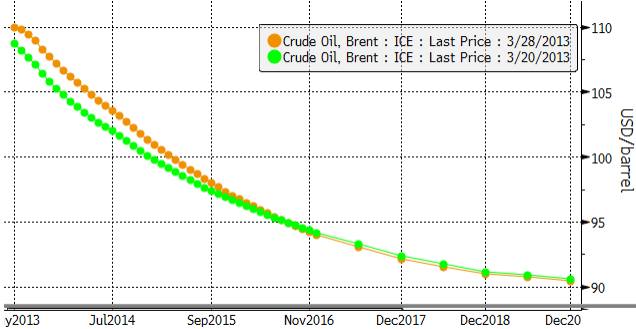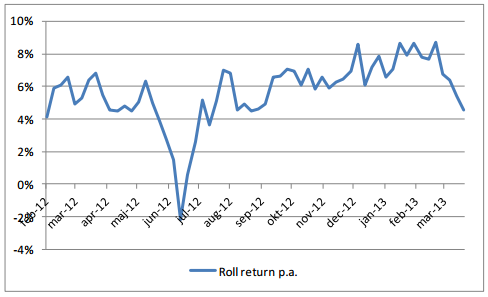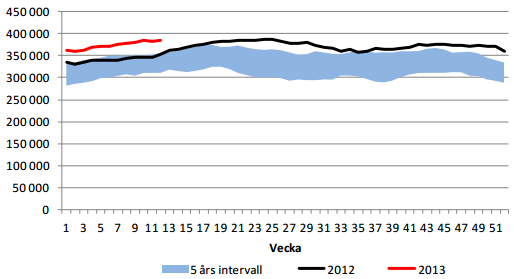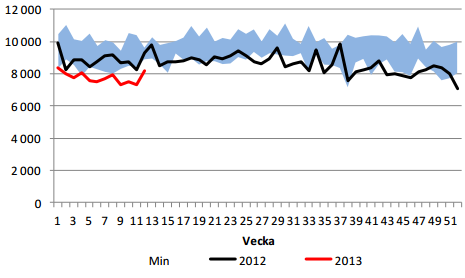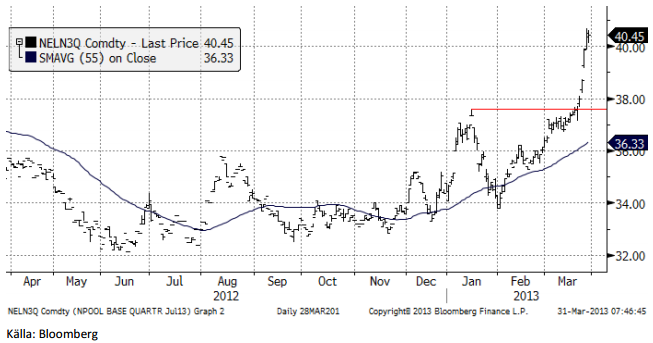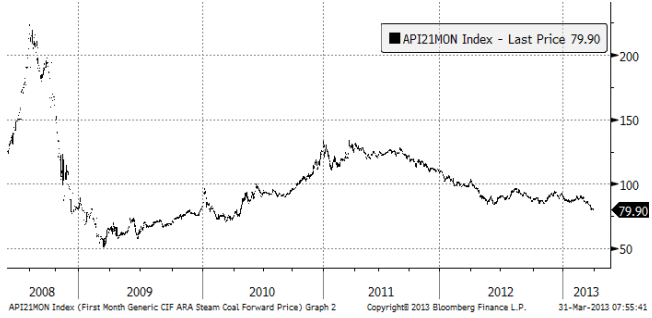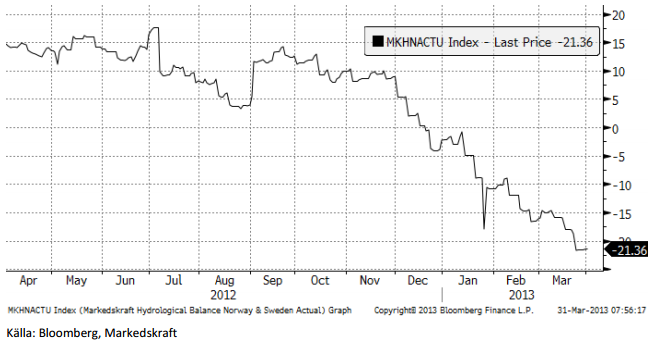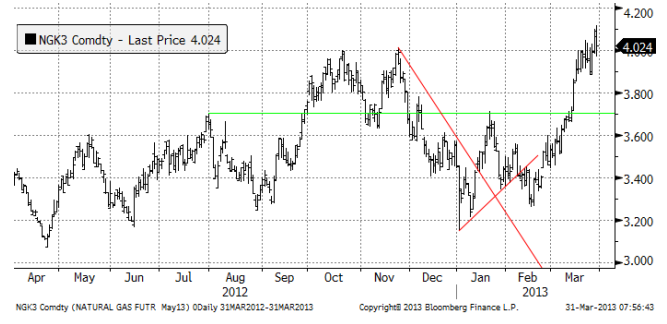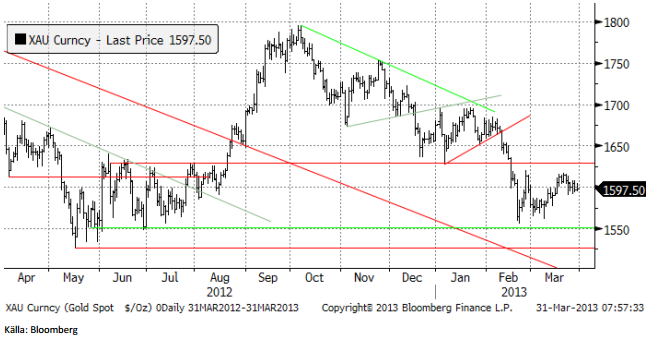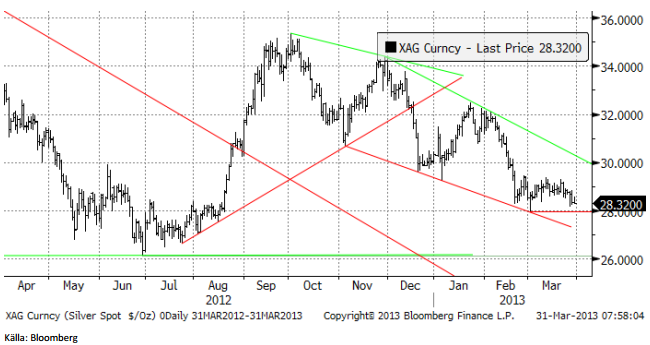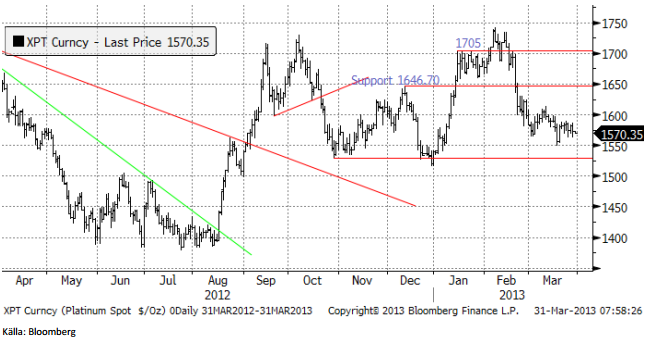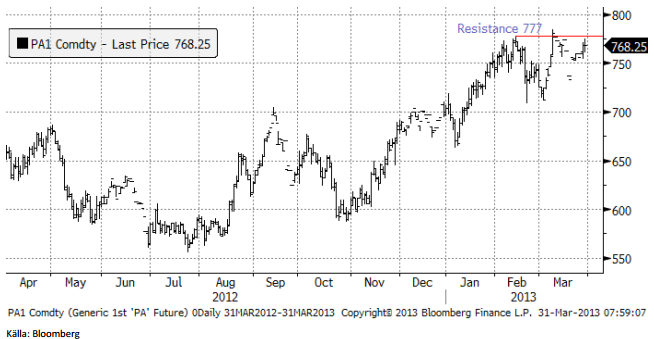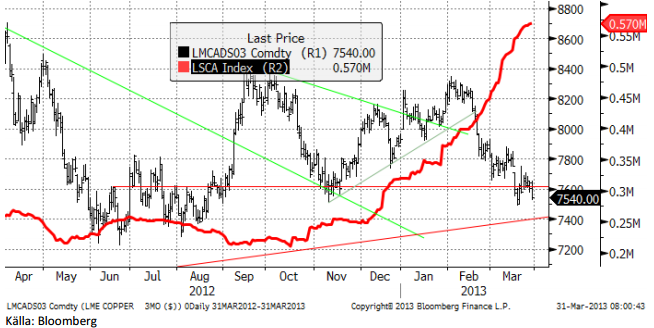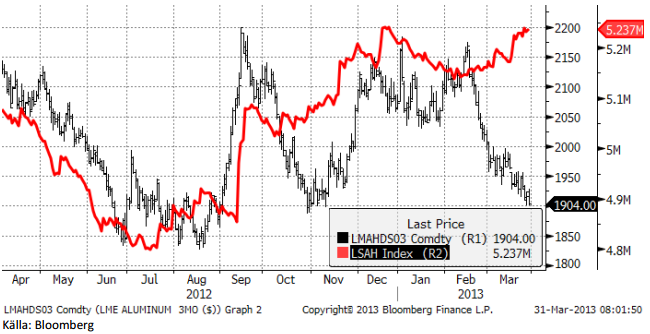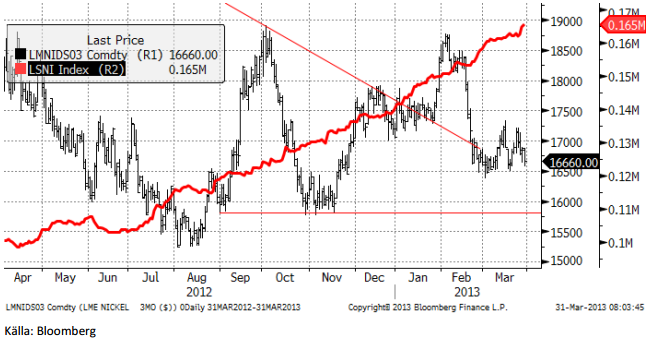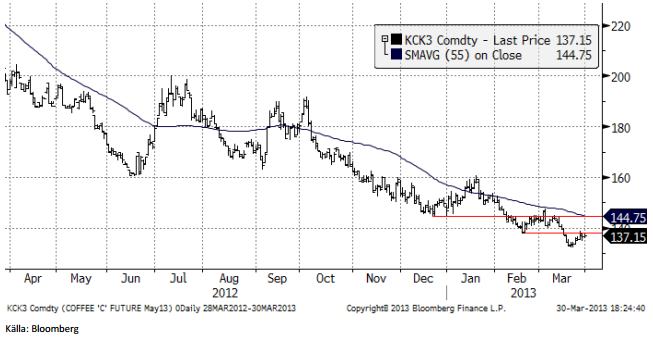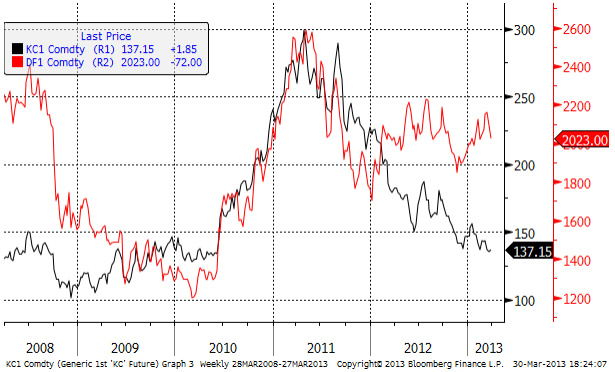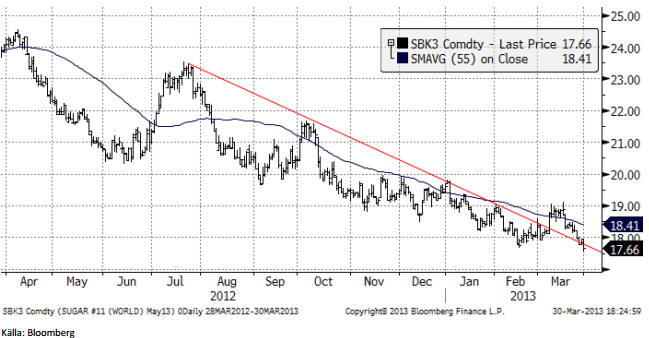Analys
SEB – Råvarukommentarer, 1 april 2013

Rekommendationer
*) Avkastningen avser 1:1 råvarucertifikat där de ingår i rekommendationen. I den aktuella tabellen ovan har jag tagit prisförändringen den senaste veckan sedan det förra veckobrevet publicerades.
Inledning
Den här veckans veckobrev måste handla primärt om den ultrabaissiga Stocks- & Plantingsrapporten från USDA i torsdags. Den fick majs och vete att falla limit down och det kommer att vara nerförsbacke härifrån.
Marknadens missbedömning var en av de största någonsin och marknadsrörelsen på Skärtorsdagen en av de största någonsin, i majs bara dämpad av den största tillåtna prisrörelsen. Sådden av majs väntas ske på 97.3 miljoner acres, något över marknadens förväntningar. Det är den största arealen sedan 1936.
De amerikanska börserna var stängda på Långfredagen, men är öppna på Annandag Påsk. Europa är dock stängt och öppnar först på tisdag. Vi kan förvänta oss betydligt lägre priser på tisdag.
Läsaren kanske kommer ihåg att jag här förra veckan skrev att den rekyl uppåt som vi sett fram till i torsdags, var ett bra tillfälle för lantbrukare att prissäkra. Jag skrev också att risk / reward var på nedsidan, eftersom de senaste rapporterna lett till uppgångar. Nu tänker förmodligen många att ”det är för sent” att prissäkra. I synnerhet som priserna kommer stå ännu lägre på tisdag när Europa öppnar. Att inte prissäkra på tisdag tror jag är ett misstag. Det kommer säkerligen att gå nedåt härifrån. Låt inte ett misstag bli ett misslyckande.
Vi går över till säljrekommendation på alla grödor.
Stocks & Plantings – rapporten i siffror
Lagren av vete, majs och sojabönor var per den 1 mars betydligt högre än vad marknaden förväntat sig, som vi ser i tabellen nedan.
Lagerestimaten år så stora att man undrar om det inte var fel – för låga siffror i decemberrapporten, eller om lagren nu möjligtvis är för stora. Om marknaden tror på siffrorna, och det gör den med all säkerhet, så finns knappast längre någon anledning till oro för att det är kallt och sådden blivit försenad. Vad gäller sojabönor försvann också oron för att sojabönorna ska ta slut i USA innan Brasilien får ut sina.
Sådd areal, som vi ser nedan hade marknadens analytiker bättre koll på, utom för vårvete och durum. Men vi vet redan tidigare att sådden väntas bli mycket stor i år.
Nedan ser vi prisförändringarna på de senaste årens rapportdagar. Prisreaktionen är uppmätt i respektive års decemberkontrakt för vete och majs och november för sojabönor.
Råvaruindex
I diagrammet nedan ser vi SEB:s råvaruindex (svart) och det svenska aktieindexet OMXS30 (röd).
Den som vill investera i indexet och den investeringsstrategi som ligger bakom kan läsa mer om certifikatet RAVAROR S.
Råolja – Brent
Oljepriset har fortsatt att falla. Vi tror att priset kommer att fortsätta ligga på den här nivån och rekommenderar köp.
Det är framförallt terminer med kort löptid som har fallit. Backwardation har minskat, som vi ser i diagrammet nedan.
Det betyder också att rullningsavkastningen man får genom att vara köpt olja via terminer har minskat. Å andra sidan har spotpriset blivit billigare, så det jämnar ut sig. Nedan ser vi roll returns mellan andra och fjärde positions terminskontrakt på Brent som har minskat den senaste månaden. Med andra positions terminskontrakt menas det terminskontrakt som förfaller om två månader och med fjärde position, det som förfaller om fyra månader.
Lagren och lagerförändringarna i USA per den 22 mars ser vi nedan, enligt Department of Energy och American Petroleum Institute.
Notera att heating oil minskade kraftigt, pga det kalla vädret och att råoljelagren fyllts på ytterligare. Det beror på att importen noterade en ovanligt stor ökning från veckan innan.
Nedan ser vi amerikanska råoljelager enligt DOE i tusen fat. Den svarta kurvan är 2012 års lagernivåer vecka för vecka och den lilla röda linjen är 2013 års nivå. Vi ser att lagernivåerna fortsätter att vara högre än de varit sedan 2007 för den här tiden på året.
I veckans statistik ser vi att importen ökade till över 8 miljoner fat per dag.
Vi rekommenderar köp av OLJA S, men inte av BULL OLJA S. Nu när priset dessutom kommit ner mot den lägre delen av det etablerade prisintervallet 105 – 120 dollar är läget att köpa OLJA S särskilt bra.
Elektricitet
Priset el har fortsatt att rusa. Den hydrologiska balansen visar stort underskott och skulle detta ha inträffat för några år sedan skulle vi ha mycket högre elpris än vad vi har nu. Sverige har exporterat vattenkraften eftersom det varit lönsamt att göra det.
Kolpriserna som styr priset på el på längre sikt har däremot gått i motsatt riktning, som vi ser i ett femårsdiagram nedan. Priset är i dollar per ton.
Den hydrologiska balansen för NordPools börsområde har sjunkit ytterligare från -18.68 TWh till -21.36 TWh.
Sammanfattningsvis. Vi rekommenderar en köpt position i elpriset. För normal risknivå väljer man EL S. Den som vill ta mer risk kan välja BULL EL X2 S och den som vill ta riktigt mycket risk och få fyra gångers hävstång på dagliga prisförändringar väljer BULL EL X4 S.
Naturgas
Amerikansk naturgas har lagt sig över 4 dollar. Lagernivåerna är lägre än tidigare år vid samma tid.
Guld & Silver
Guldpriset har inte reagerat på Cypernkris och Nordkorea-fars som det borde. Uppgången i priset borde ha varit större. När dessa faktorer klingar av och guldpriset får en nedgångsfas kan prisfallet bli lättare avklarat, kanske ner till 1550.
Detsamma gäller silver, som skulle kunna falla ner till 27 dollar, genom stödet på 28 dollar.
Platina & Palladium
Platina rör sig sakta nedåt, i vad som ser ut som en förberedelse för en uppgång igen. På BRIC:s konferensen förra veckan sade Rysslands vice premiärminister att Ryssland och Sydafrika ska bilda en OPEC-liknande kartell för platina. Tillsammans står länderna för 80% av global gruvproduktion av platina. Blir detta verklighet och de sätter in begränsningar i tillförseln, kan priset gå upp väsentligt.
Palladium har rört sig sidledes och uppgången ser ut att ha tappat den hel del av sitt momentum. En uppgång över 777 dollar skulle bekräfta att uppåttrenden är intakt.
Koppar
Kopparmarknaden har fortsatt att utveckla sig svagt, samtidigt som lagren vid LME har fortsatt att öka. Priset ser ut att vara på väg ner mot historiska bottennivåer, där en del producenter inte går runt. Detta är vad som kallas för kopparprisets ”fundamentala golv”. På lite längre sikt kan det vara en bra idé att köpa på dessa nivåer.
Den tekniska bilden ger stöd till vår neutrala position. Vi är positiva till basmetaller på sikt men avvaktar bättre köptillfällen alternativt väljer någon annan basmetall.
Som vi skrivit tidigare tyder mycket på ökat utbud för koppar, vilket ökar risken för en lite trögare marknad. Vi ser inte den stora potentialen på koppar på uppsidan just nu. Vi rekommenderar därför en fortsatt neutral position. För den som vill satsa på ett starkare tillväxtscenario (än konsensus) i Kina är koppar däremot alltid ett intressant alternativ.
Aluminium
Aluminium har fallit ner till ”botten” i det intervall som priset handlats i det senaste året. Vid 1900 dollar finns ett starkt stöd och vid 1850 ungefär ytterligare ett. Vid dessa nivåer har producenter svårt att gå runt, det ”fundamentala golvet”. Vi tror att aluminium är attraktivt att köpa på den här nivån och rekommenderar ALUMINIUM S.
Zink
Priset på zink har fallit i sympati med andra basmetaller. Däremot ser vi att lagren vid LME (röd kurva) har passerat sin högsta nivå. Kurvan pekar nu nedåt. Även för zink ligger priserna lågt i förhållande till det prisintervall som metallen handlats inom det senaste året. Vi rekommenderar en köpt position i ZINK S.
Nickel
Lagerökningen är som vi ser (röd linje) stadig för nickel. Priset på nickel har inte fallit lika långt ner i det senaste årets prisintervall. En del frågar sig om man ska tolka detta som att nickel handlar starkare än andra metaller eller om nickel är dyrt i förhållande till andra metaller. Förmodligen lite av båda sakerna.
Vi rekommenderar köp av NICKEL S eller BULL NICKEL X2 / X4 S för den som vill ta mer risk. Vi varnade för en rekyl, och den kom. Priset har fallit mer än ”befarat”, men är nu på väldigt attraktiva nivåer.
Kaffe
Kaffepriset (maj 2013) har rekylerat upp till vad som tidigare varit ett stöd och nu är ett motstånd. Priset på Arabica ”borde” vara på väg att vända upp, men vändningen har dröjt. Vi väntar med köprekommendation till dess vi sett något tydligare tecken på att trenden kan ha vänt. Den har inte gjort det än.
Priset på den sämre kaffesorten Robusta har hållit sig stark. I diagrammet nedan ser vi dess prisutveckling som dne röda kurvan. Man kan tolka det som att efterfrågan på kaffe äger rum i tillväxtländer, som väljer den sämre – och billigare Robustan. Rika länder som väljer den lyxigare Arabican, har uppenbarligen inte haft lika stor efterfrågan. Brasilianska bönder lär också ha sålt mest av sämre kvaliteter av arabica. Den högsta kvaliteten finns fortfarande kvar på gårdarna.
Vi fortsätter med neutral rekommendation.
Socker
Sockerpriset (maj 2013) har också fortsatt att falla. Det såg ut som ett försök till trendvändning i mars, men detta vändes i sin motsats.
Vi tror att en trendvändning kan vara på gång, men väntar till dess att den bekräftar sig lite bättre. Vi fortsätter alltså att förhålla oss neutralt till socker.
[box]SEB Veckobrev Veckans råvarukommentar är producerat av SEB Merchant Banking och publiceras i samarbete och med tillstånd på Råvarumarknaden.se[/box]
Disclaimer
The information in this document has been compiled by SEB Merchant Banking, a division within Skandinaviska Enskilda Banken AB (publ) (“SEB”).
Opinions contained in this report represent the bank’s present opinion only and are subject to change without notice. All information contained in this report has been compiled in good faith from sources believed to be reliable. However, no representation or warranty, expressed or implied, is made with respect to the completeness or accuracy of its contents and the information is not to be relied upon as authoritative. Anyone considering taking actions based upon the content of this document is urged to base his or her investment decisions upon such investigations as he or she deems necessary. This document is being provided as information only, and no specific actions are being solicited as a result of it; to the extent permitted by law, no liability whatsoever is accepted for any direct or consequential loss arising from use of this document or its contents.
About SEB
SEB is a public company incorporated in Stockholm, Sweden, with limited liability. It is a participant at major Nordic and other European Regulated Markets and Multilateral Trading Facilities (as well as some non-European equivalent markets) for trading in financial instruments, such as markets operated by NASDAQ OMX, NYSE Euronext, London Stock Exchange, Deutsche Börse, Swiss Exchanges, Turquoise and Chi-X. SEB is authorized and regulated by Finansinspektionen in Sweden; it is authorized and subject to limited regulation by the Financial Services Authority for the conduct of designated investment business in the UK, and is subject to the provisions of relevant regulators in all other jurisdictions where SEB conducts operations. SEB Merchant Banking. All rights reserved.
Analys
Brent crude ticks higher on tension, but market structure stays soft

Brent crude has climbed roughly USD 1.5-2 per barrel since Friday, yet falling USD 0.3 per barrel this mornig and currently trading near USD 67.25/bbl after yesterday’s climb. While the rally reflects short-term geopolitical tension, price action has been choppy, and crude remains locked in a broader range – caught between supply-side pressure and spot resilience.

Prices have been supported by renewed Ukrainian drone strikes targeting Russian infrastructure. Over the weekend, falling debris triggered a fire at the 20mtpa Kirishi refinery, following last week’s attack on the key Primorsk terminal.
Argus estimates that these attacks have halted ish 300 kbl/d of Russian refining capacity in August and September. While the market impact is limited for now, the action signals Kyiv’s growing willingness to disrupt oil flows – supporting a soft geopolitical floor under prices.
The political environment is shifting: the EU is reportedly considering sanctions on Indian and Chinese firms facilitating Russian crude flows, while the U.S. has so far held back – despite Bessent warning that any action from Washington depends on broader European participation. Senator Graham has also publicly criticized NATO members like Slovakia and Hungary for continuing Russian oil imports.
It’s worth noting that China and India remain the two largest buyers of Russian barrels since the invasion of Ukraine. While New Delhi has been hit with 50% secondary tariffs, Beijing has been spared so far.
Still, the broader supply/demand balance leans bearish. Futures markets reflect this: Brent’s prompt spread (gauge of near-term tightness) has narrowed to the current USD 0.42/bl, down from USD 0.96/bl two months ago, pointing to weakening backwardation.
This aligns with expectations for a record surplus in 2026, largely driven by the faster-than-anticipated return of OPEC+ barrels to market. OPEC+ is gathering in Vienna this week to begin revising member production capacity estimates – setting the stage for new output baselines from 2027. The group aims to agree on how to define “maximum sustainable capacity,” with a proposal expected by year-end.
While the IEA pegs OPEC+ capacity at 47.9 million barrels per day, actual output in August was only 42.4 million barrels per day. Disagreements over data and quota fairness (especially from Iraq and Nigeria) have already delayed this process. Angola even quit the group last year after being assigned a lower target than expected. It also remains unclear whether Russia and Iraq can regain earlier output levels due to infrastructure constraints.
Also, macro remains another key driver this week. A 25bp Fed rate cut is widely expected tomorrow (Wednesday), and commodities in general could benefit a potential cut.
Summing up: Brent crude continues to drift sideways, finding near-term support from geopolitics and refining strength. But with surplus building and market structure softening, the upside may remain capped.
Analys
Volatile but going nowhere. Brent crude circles USD 66 as market weighs surplus vs risk

Brent crude is essentially flat on the week, but after a volatile ride. Prices started Monday near USD 65.5/bl, climbed steadily to a mid-week high of USD 67.8/bl on Wednesday evening, before falling sharply – losing about USD 2/bl during Thursday’s session.

Brent is currently trading around USD 65.8/bl, right back where it began. The volatility reflects the market’s ongoing struggle to balance growing surplus risks against persistent geopolitical uncertainty and resilient refined product margins. Thursday’s slide snapped a three-day rally and came largely in response to a string of bearish signals, most notably from the IEA’s updated short-term outlook.
The IEA now projects record global oversupply in 2026, reinforcing concerns flagged earlier by the U.S. EIA, which already sees inventories building this quarter. The forecast comes just days after OPEC+ confirmed it will continue returning idle barrels to the market in October – albeit at a slower pace of +137,000 bl/d. While modest, the move underscores a steady push to reclaim market share and adds to supply-side pressure into year-end.
Thursday’s price drop also followed geopolitical incidences: Israeli airstrikes reportedly targeted Hamas leadership in Doha, while Russian drones crossed into Polish airspace – events that initially sent crude higher as traders covered short positions.
Yet, sentiment remains broadly cautious. Strong refining margins and low inventories at key pricing hubs like Europe continue to support the downside. Chinese stockpiling of discounted Russian barrels and tightness in refined product markets – especially diesel – are also lending support.
On the demand side, the IEA revised up its 2025 global demand growth forecast by 60,000 bl/d to 740,000 bl/d YoY, while leaving 2026 unchanged at 698,000 bl/d. Interestingly, the agency also signaled that its next long-term report could show global oil demand rising through 2050.
Meanwhile, OPEC offered a contrasting view in its latest Monthly Oil Market Report, maintaining expectations for a supply deficit both this year and next, even as its members raise output. The group kept its demand growth estimates for 2025 and 2026 unchanged at 1.29 million bl/d and 1.38 million bl/d, respectively.
We continue to watch whether the bearish supply outlook will outweigh geopolitical risk, and if Brent can continue to find support above USD 65/bl – a level increasingly seen as a soft floor for OPEC+ policy.
Analys
Waiting for the surplus while we worry about Israel and Qatar

Brent crude makes some gains as Israel’s attack on Hamas in Qatar rattles markets. Brent crude spiked to a high of USD 67.38/b yesterday as Israel made a strike on Hamas in Qatar. But it wasn’t able to hold on to that level and only closed up 0.6% in the end at USD 66.39/b. This morning it is starting on the up with a gain of 0.9% at USD 67/b. Still rattled by Israel’s attack on Hamas in Qatar yesterday. Brent is getting some help on the margin this morning with Asian equities higher and copper gaining half a percent. But the dark cloud of surplus ahead is nonetheless hanging over the market with Brent trading two dollar lower than last Tuesday.

Geopolitical risk premiums in oil rarely lasts long unless actual supply disruption kicks in. While Israel’s attack on Hamas in Qatar is shocking, the geopolitical risk lifting crude oil yesterday and this morning is unlikely to last very long as such geopolitical risk premiums usually do not last long unless real disruption kicks in.
US API data yesterday indicated a US crude and product stock build last week of 3.1 mb. The US API last evening released partial US oil inventory data indicating that US crude stocks rose 1.3 mb and middle distillates rose 1.5 mb while gasoline rose 0.3 mb. In total a bit more than 3 mb increase. US crude and product stocks usually rise around 1 mb per week this time of year. So US commercial crude and product stock rose 2 mb over the past week adjusted for the seasonal norm. Official and complete data are due today at 16:30.
A 2 mb/week seasonally adj. US stock build implies a 1 – 1.4 mb/d global surplus if it is persistent. Assume that if the global oil market is running a surplus then some 20% to 30% of that surplus ends up in US commercial inventories. A 2 mb seasonally adjusted inventory build equals 286 kb/d. Divide by 0.2 to 0.3 and we get an implied global surplus of 950 kb/d to 1430 kb/d. A 2 mb/week seasonally adjusted build in US oil inventories is close to noise unless it is a persistent pattern every week.
US IEA STEO oil report: Robust surplus ahead and Brent averaging USD 51/b in 2026. The US EIA yesterday released its monthly STEO oil report. It projected a large and persistent surplus ahead. It estimates a global surplus of 2.2 m/d from September to December this year. A 2.4 mb/d surplus in Q1-26 and an average surplus for 2026 of 1.6 mb/d resulting in an average Brent crude oil price of USD 51/b next year. And that includes an assumption where OPEC crude oil production only averages 27.8 mb/d in 2026 versus 27.0 mb/d in 2024 and 28.6 mb/d in August.
Brent will feel the bear-pressure once US/OECD stocks starts visible build. In the meanwhile the oil market sits waiting for this projected surplus to materialize in US and OECD inventories. Once they visibly starts to build on a consistent basis, then Brent crude will likely quickly lose altitude. And unless some unforeseen supply disruption kicks in, it is bound to happen.
US IEA STEO September report. In total not much different than it was in January

US IEA STEO September report. US crude oil production contracting in 2026, but NGLs still growing. Close to zero net liquids growth in total.

-

 Nyheter4 veckor sedan
Nyheter4 veckor sedanMeta bygger ett AI-datacenter på 5 GW och 2,25 GW gaskraftverk
-

 Nyheter4 veckor sedan
Nyheter4 veckor sedanAker BP gör ett av Norges största oljefynd på ett decennium, stärker resurserna i Yggdrasilområdet
-

 Analys4 veckor sedan
Analys4 veckor sedanBrent edges higher as India–Russia oil trade draws U.S. ire and Powell takes the stage at Jackson Hole
-

 Nyheter3 veckor sedan
Nyheter3 veckor sedanMahvie Minerals är verksamt i guldrikt område i Finland
-

 Analys4 veckor sedan
Analys4 veckor sedanIncreasing risk that OPEC+ will unwind the last 1.65 mb/d of cuts when they meet on 7 September
-

 Nyheter4 veckor sedan
Nyheter4 veckor sedanNeil Atkinson spår att priset på olja kommer att stiga till 70 USD
-

 Nyheter2 veckor sedan
Nyheter2 veckor sedanEurobattery Minerals satsar på kritiska metaller för Europas självförsörjning
-

 Analys2 veckor sedan
Analys2 veckor sedanOPEC+ in a process of retaking market share


